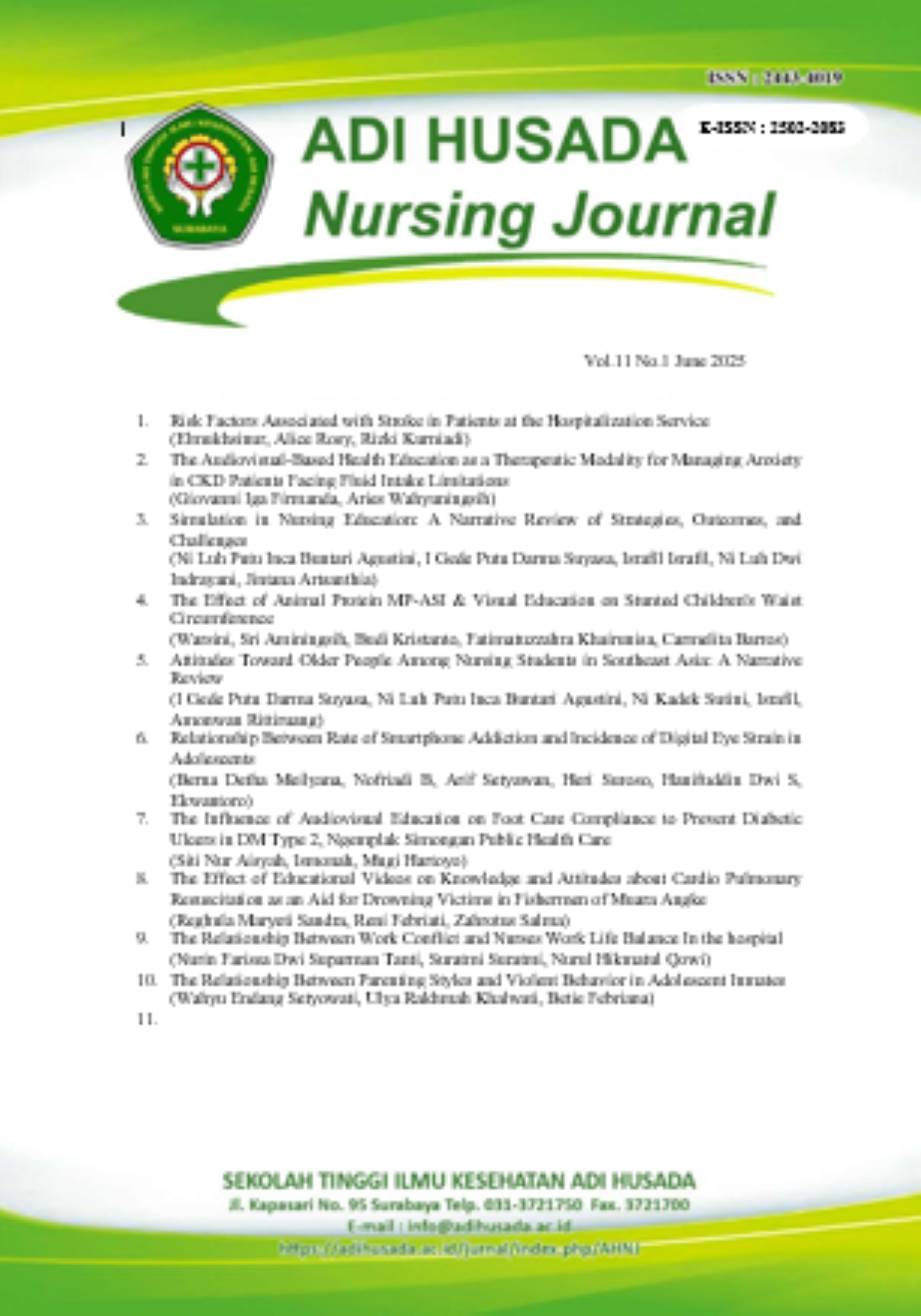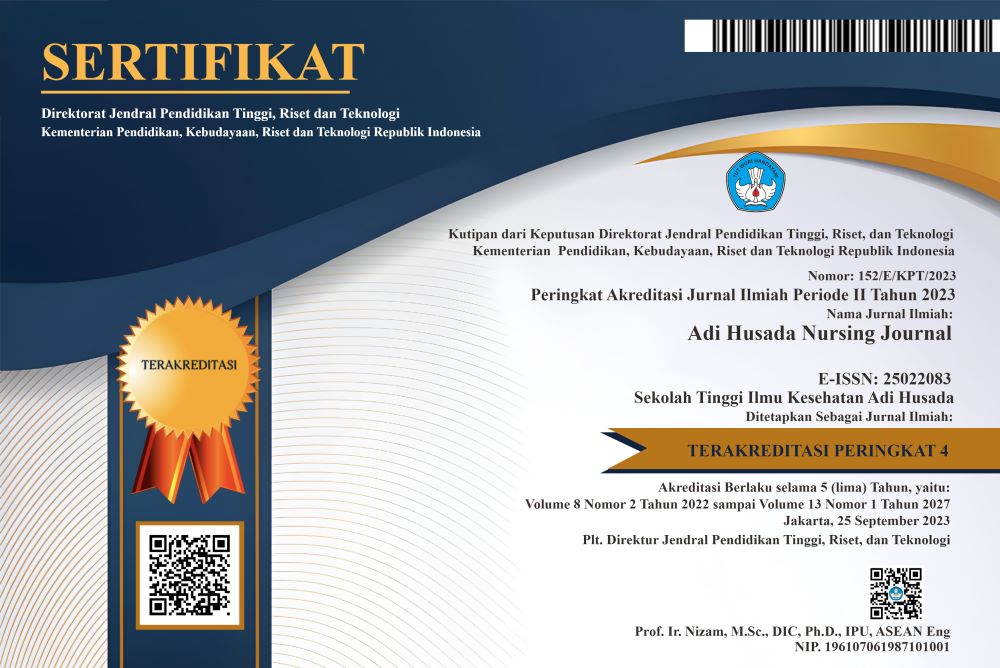Relationship Between Rate of Smartphone Addiction and Incidence of Digital Eye Strain in Adolescents
Abstract
The impact of the COVID-19 pandemic has had a big impact on the world of education. Because of online learning, smartphones have a very important role in meeting these needs. Smartphones have a negative impact that can be felt by students when used in their continuous learning is Digital Eye Strain (DES) or often referred to as eye fatigue. This study aims to determine the relationship between the rate of smartphone addiction and the incidence of digital eye strain in adolescents aged 13 – 15 years at Yohanes Gabriel Pare Junior High School. This study used a cross-sectional design. The sample selection used purposive sampling with a total of 115 respondents. The research was conducted using DES questionnaires. The results of the Kendall's Tau test showed that the correlation test results were known to have a significance value, or Sig. (2-tailed), between the variable level of smartphone addiction and the incidence of DES was 0.001. While the correlation is significant at 0.05, the value is 0.001 < 0.05. There is a significant relationship between the level of smartphone addiction and the incidence of digital eye strain in adolescents aged 13-15 years at Yohanes Gabriel Pare Junior High School. Smartphone addiction can affect eye function. The duration and frequency of prolonged smartphone use can affect dry eyes, redness, and the onset of DES symptoms.
References
Apuke, Oberiri Destiny, & Iyendo, Timothy Onosahwo. (2018). University students' usage of the internet resources for research and learning: forms of access and perceptions of utility. Heliyon, 4(12), e01052-e01052. doi: 10.1016/j.heliyon.2018.e01052
Bahkir, Fayiqa Ahamed, & Grandee, Srinivasan Subramanian. (2020). Impact of the COVID-19 lockdown on digital device-related ocular health. Indian Journal of Ophthalmology, 68(11), 2378-2383. doi: 10.4103/green. IJO_2306_20
Bhattacharya, Sudip, Saleem, Sheikh Mohd, & Singh, Amarjeet. (2020). Digital eye strain in the era of the COVID-19 pandemic: An emerging public health threat. Indian Journal of Ophthalmology, 68(8), 1709-1710. doi: 10.4103/green. IJO_1782_20
Dedyerianto, Dedyerianto %J Al-TA'DIB: Journal of Educational Studies. (2020). The Influence of the Internet and Social Media on Learning Independence and Student Learning Outcomes. 12(2), 208-225.
Gammoh, Yazan. (2021). Digital Eye Strain and Its Risk Factors Among a University Student Population in Jordan: A Cross-Sectional Study. Cureus, 13(2), e13575-e13575. doi: 10.7759/cureus.13575
Nisa, Haerunnisa, Permana, Adrian, & Firmansyah, Ricky %J Thematic: Journal of Information Communication Technology. (2020). The Role of Smartphones in the World of Education during the Covid-19 Pandemic. 7(2), 140-146.
Reynanda, Syifa Aulia %J Journal of Community Health. (2021). The Effect of Online Learning on Eye Health during the Pandemic. 3(2), 26-38.
Saputra, Firman Firdauz, & Inayah, Zufra %J PREPOTIF: Journal of Public Health. (2021). EFFECTS OF NOMOPHOBIA AND MOBILE PHONE USE WITH EYE STRAIN IN UNIVERSITY STUDENTS. 5(2), 1284-1292.
Shantakumari, N., Eldeeb, R., Sreedharan, J., & Gopal, K. (2016). Computer use and vision-related problems among university students in ajman, United arab emirate. Annals of medical and health sciences research, 4(2), 258-263. doi: 10.4103/2141-9248.129058
Sheppard, Amy L., & Wolffsohn, James S. (2018). Digital eye strain: prevalence, measurement and amelioration. BMJ open ophthalmology, 3(1), e000146-e000146. doi: 10.1136/bmjophth-2018-000146
Sumpa, Sertika Geraria, & Barkah, Asep %J Journal of Education and Counseling. (2022). The Effect of Smartphone Use on Adolescent Social Personal Development at SMPN 6 Jelimpo Kal-Bar in 2022. 4(3), 2074-2079.
Tambun, Madschen Sia Mei Ol Siska Selvija. (2021). Eye Fatigue and Complaints of MSDs for Online Lectures During the COVID-19 Pandemic in Students in Three Faculties of Sari Mulia University (Industrial Engineering Study Program, D-IV Health Promotion and Management Study Program). Journal of Industrial Engineering and Systems Media, 5(2), 92-101. doi: 10.35194/jmtsi.v5i2.1427
Widyadana, Nadia Dwi J LoroNG: Media of Socio-Cultural Studies. (2022). The Effect of Intensity of Gadget Use in the Pandemic Era on Eye Fatigue. 11(1), 58-71.
Keywords
Digital Eye Strain, Eye Fatigue, Smartphone Addiction

This work is licensed under a Creative Commons Attribution 4.0 International License.








